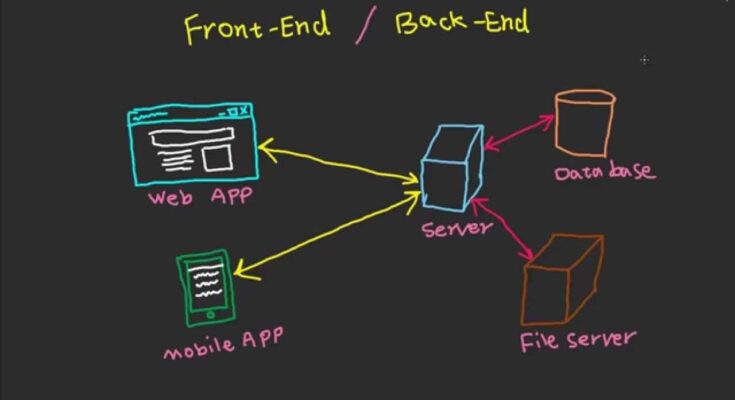Organizations typically have internal tools requiring entry to extra detailed data than public APIs present. IoT dashboards often must show real-time knowledge from quite a few sensors and devices. The resulting binary is smaller and boots up virtually instantly—a key benefit for scalable, cost-efficient BFFs. Centralized logging and distributed tracing allow you to pinpoint latency, failures, and bottlenecks. In this section, we’ll walk by way of how does frontend and backend work together important issues, reveal sensible approaches in modern C#/.NET, and outline strategies for robustness and security.
DevOps and agile methodologies proceed to form the deployment process. These approaches emphasize collaboration, automation, and steady enchancment. One creates the attractive interface customers love, whereas the other handles all of the heavy lifting behind the scenes. The backend processes this order, updates the database to include your order details, and sends a affirmation back to the frontend, which then exhibits you an estimated supply time. All of this happens in the background, making certain a smooth ordering process for you.
- You’ll see why BFFs have turn into a vital architectural alternative for software program teams constructing trendy applications.
- It’s nice to have your backend responsible for building HTML responses, and get more fancy when you see the actual need to take action.
- Customers respect fast load occasions, intuitive navigation, and responsive design, all of which could be achieved with a well-built full-stack app.
- Net serversare really fast with this task, and web apps are kinda clumsy about it.
- In this section, we’ll walk via essential issues, show sensible approaches in fashionable C#/.NET, and description strategies for robustness and safety.
- Use caching strategies to reduce back load occasions and enhance knowledge retrieval speeds.
It offers a consistent surroundings for the application to run, guaranteeing that it behaves the identical way across different servers. Orchestration instruments like Kubernetes further simplify the deployment process by automating the management and scaling of containers. They continuously communicate by way of something referred to as APIs (Application Programming Interfaces). When you click a button on a website, it often sends a request to the backend, which processes it and sends information again to the frontend.
This article is an overview of what goes on between the backend andthe frontend of a web utility – how the two communicate. There are many alternative methods tips on how to structure a web utility.The frontend can take completely different varieties, and it can be daunting tounderstand tips on how to connect the 2. Multiple BFFs imply a quantity of endpoints to observe and secure, increasing complexity. By aggregating and formatting information appropriately, BFFs cut back the quantity of knowledge transmitted, enhancing efficiency. GRPC enables you to efficiently fetch and combination inner data—especially useful when BFFs require frequent, small, and performant service-to-service calls.
BFFs can enforce safety measures tailored to each consumer, ensuring information is appropriately protected. The processing microservice can receive from the queue and deal with the long-running job, updating status elsewhere for the consumer to verify later. For BFFs that serve internet and cellular purchasers, tuning JSON serialization ensures payloads are lean and parsing is quick on all platforms. Constructing a cloud-ready BFF isn’t just about following the best architectural sample; it’s about utilizing the right tools and techniques for the job.
What Are The Most Important Differences Between Frontend And Backend?
Backend refers to server-side scripts which allow communication between the person and the app. We can say it is the presentation layer and also referred to as client-side because it’s dealt with by the shopper browser (user). Clean, maintainable code is the spine of any successful full-stack app. Use meaningful variable names, consistent indentation, and clear feedback. This approach makes your code easier to know and simplifies debugging and future updates.
Why Does Understanding The Distinction Matter?
A core responsibility of the BFF is to orchestrate calls to a number of downstream services, mixture and rework knowledge, and current a client-optimized response. Doing this effectively requires the best instruments and strategies in .NET. BFF developed naturally as organizations shifted from monolithic applications to microservices architectures. As microservices gained recognition, the need arose for specialized API layers able to aggregating knowledge and simplifying consumer interactions.
The Advantages Of Bff
Those sources are static, and must be dealt with as in the first example case. Such static files can be served by the online application (application server) itself, but normally that is thought-about to be in poor taste. Internet servers are really quick with this task, and internet apps are kinda clumsy about it. The front- and backend make this potential by inflicting requests to be despatched and answering with responses.
Sure, the Backend For Frontend sample is certainly one of several kinds of microservice architecture patterns. We may even help you perceive these two phrases with some examples and case studies. We take pride in our ability to develop innovative options to complicated enterprise community issues.
Teams need expertise in both frontend and backend growth to effectively implement BFFs. While HTTP APIs are good for request/response patterns, not every workflow is finest modeled as a synchronous operation. For operations that take longer, are resource-intensive, or could involve multiple microservices, asynchronous messaging can decouple your BFF from downstream complexity. A common strategy is for BFFs to speak with downstream microservices via gRPC and expose REST/JSON endpoints to frontend shoppers. With APIs completely tailored, client-side code becomes simpler and easier to take care of, leading to cleaner frontend applications. Every of these consumer applications varies tremendously when it comes to information consumption patterns, responsiveness necessities, and consumer interactions.
At Upforce Tech, we understand these differences and provide the most effective front-end and back-end development solutions tailored to your wants. Whether Or Not you’re building a easy web site or a fancy software, we’ve builders who can ensure each front-end and back-end work seamlessly together. A full-stack developer works on both the frontend and backend of an online software. They’re skilled in the entire expertise stack and can handle everything from UI design to database architecture.
Aggregated responses minimize the number of API calls, decreasing latency and enhancing consumer expertise. This design retains your BFFs lean and your consumer experiences snappy, even when workflows are complex or time-consuming. Downstream companies might be slow or unavailable, and community points are inevitable. BFFs should deal with such failures gracefully, shielding shoppers from backend instability. Frontend teams can evolve independently, making API changes without impacting different consumer purposes. BFFs focus explicitly on creating APIs optimized for specific frontend shoppers.




